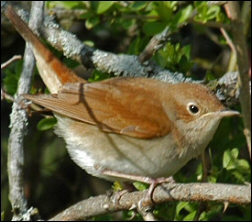Asturias

Birding Asturias
The Principality of Asturias is an autonomous community within the kingdom of Spain, former Kingdom of Asturias in the Middle Ages. It is situated on the Spanish north coast facing the Cantabrian Sea (Mar Cantábrico, the Spanish name for the Bay of Biscay). Asturias is bordered on the east by Cantabria, on the south by Castilla y León, on the west by Galicia (Lugo), and on the north by the Cantabrian Sea.
The Cantabrian Mountains (Cordillera Cantábrica) form Asturias’s natural border with the province of León to the south. In the eastern range, the Picos de Europa National Park contains the highest and arguably most spectacular mountains, rising to 2648 metres (8688 feet) at the Torrecerredo peak. Other notable features of this predominantly-limestone range are the Parque Natural de Redes in the central east, the central Ubiñas south of Oviedo, and the Parque Natural de Somiedo in the west. The Cantabrian mountains offer opportunities for activities such as climbing, walking, skiing and caving, and extend some 200 kilometres in total, as far as Galicia province to the west of Asturias, and Cantabria province to the east.
The Asturian coastline is extensive, with hundreds of beaches, coves and natural sea caves. Notable examples include the Playa del Silencio (Beach of Silence) near the fishing village of Cudillero (west of Gijón), as well as the many beaches surrounding the summer resort of Llanes, such as the Barro, Ballota and Torimbia (the latter a predominantly nudist beach). Most of Asturias’ beaches are sandy, clean and bordered by steep cliffs, on top of which it is not unusual to see grazing livestock.The key features of Asturian geography are its rugged coastal cliffs and the mountainous interior. The climate of Asturias, as with the rest of northwest Spain, is more varied than that of southern parts of the country. Summers are generally humid and warm, with considerable sunshine, but also some rain. Winters are cold with some very cold snaps. The cold is especially felt in the mountains, where snow is present from October till May. Both rain and snow are regular weather features of Asturian winters.
-
Wikipedia
GNU Free Documentation License
http://en.wikipedia.org/wiki/Asturias
-
Number of bird species: 389
(As at August 2018)
-
Aves de Asturias: Guía de Identificación
By Mario Arce, Victor M Vazquez & Gonzalo Gil | Mundi-Prensa | 2014 | Paperback | 355 pages, 750 colour illustrations, distribution maps | Spanish Text | ISBN: 9788484766650 Buy this book from NHBS.com -
Where to Watch Birds in Northern & Eastern Spain
By Ernest FJ Garcia & Michael Rebane | Bloomsbury Publishing | 2017 | Paperback | 384 pages, 30 b/w illustrations, 125 b/w maps | ISBN: 9781472936752 Buy this book from NHBS.com
-
Coordinadora Ornioloxica d'Asturies
WebsiteCoordinadora Ornioloxica d'Asturies - La Consejería de Medio Ambiente asturiana y Luis Mario Arce realizaron una gran exposición sobre la vida y obra de Noval, que fue inaugurada en el mes de abril de 2002 y recorrerá distintos lugares de nuestra región, quedando permanentemente en el enclave mejor estudiado…
-
NP Parque Natural de Redes
WebsiteSatellite ViewEl Parque Natural de Redes, que comprende los concejos de Caso y Sobrescobio, se sitúa en el sector centro-oriental de la Cordillera Cantábrica, al sur de Asturias, ocupando una superficie de 37.803 hectáreas. -
NP Picos de Europa
WebsiteSatellite ViewSpain's oldest National Park (1918); and the second largest in size, the Picos de Europa extends over three provinces: Asturias, Cantabria and León. This remarkable limestone range is Atlantic Europe's most extensive and is famous for its vertiginous slopes that go from 225ft above sea level to the highest peak, Torre Cerredo, 8100ft. These different altitudes and its proximity to the sea give rise to an impressive variety of flora and fauna.
-
Josele J. Saiz
Tour OperatorBetter known for his wonderful birder's guesthouse in the Pyrenees [Boletas]; Josele J. Saiz guides throughout Spain and Morocco
-
2017 [09 September] - Kath & Mick Claydon - Mammals, birds and butterflies of Asturias & Cantabria
PDF ReportA 10-daytailor-madetrip arranged for us by Steve Westof Birding in Spain(www.BirdingInSpain.com)to look for wildlifein SomiedoNatural Park (Asturias) and aroundRiañosouth of thePicos de Europa. On this trip we were notconcentrating on birds, wehoped to see a bear (reasonable chance) and perhaps a wolf(much more difficult)but our interests are varied and we look at everything.
-
Birding Picos de Europa
WebpageBirding Picos de Europa is a birdwatching project located in The National Park of Picos de Europa (north of Spain) and its immediate surroundings. From our lodge, in the outskirts of the small village of Llonín (Asturias. Spain), we have easy access to the most important birdwatchings places of the National Park and its surroundings, from the Cantabrian coast to the alpine zone.
-
Birdwatch Asturias
WebsiteBlog, articles, photos and a where to watch section -
Guia de las aves de Asturias
WebsiteAn ample section of photographies and drawings illustrates many of the described birds. In addition, an extensive bibliography has the book and each species takes to its name and estatus in Castilian, Asturian, English, French and German. The book is of great interest for all the observers of birds in Asturias and the north of Spain, but it will be of special value, in addition, for many thousands of visitors of other Spanish regions and of the foreigner.

